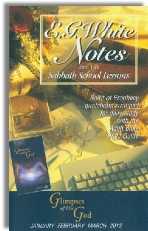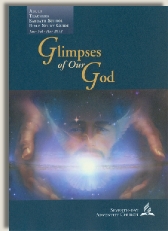|
||||||||||||||
Commentary on "Creation Care"
Day 7: Friday, February 24, 2012 - Further Study
Summary
Today’s lesson opens with a beautiful passage from Ps. 65:6 and Ps. 95:5:
“In the beginning, God was revealed in all the works of creation. It was Christ that spread the heavens, and laid the foundations of the earth. It was His hand that hung the worlds in space, and fashioned the flowers of the field. 'His strength setteth fast the mountains.’ 'The sea is His, and He made it.’
Then, the author quotes from Desire of Ages p. 20-21:
“Now sin has marred God’s perfect work, yet that handwriting remains. Even now all created things declare the glory of His excellence. There is nothing, save the selfish heart of man, that lives unto itself. (Emphasis supplied)
Observations
Comment: The curse of sin has impacted not only humans, but the whole creation (see Roman 8). The serious study of nature reveals that animals and even plants behave very much in their self-interest with survival, not 'ministry’ as the ultimate goal.
Annie Dillard in her classic work Pilgrim by Tinker Creek candidly describes her observations of nature while she lived for several months near a creek bank in rural Virginia. She portrays all manner of beauty that nature affords, but also its cruelty and heartlessness (by human standards of morality). For just one example, she writes about a frog, whose inner parts were being liquefied and sucked out by a water beetle:
A couple of summers ago I was walking along the edge of the island to see what I could see in the water, and mainly to scare frogs. Frogs have an inelegant way of taking off from invisible positions on the bank just ahead of your feet, in dire panic, emitting a froggy “Yike!” and splashing into the water. Incredibly, this amused me, and, incredibly, it amuses me still.
As I walked along the grassy edge of the island, I got better and better at seeing frogs both in and out of the water. I learned to recognize, slowing down, the difference in texture of the light reflected from mud bank, water, grass, or frog. Frogs were flying all around me. At the end of the island I noticed a small green frog. He was exactly half in and half out of the water, looking like a schematic diagram of an amphibian, and he didn’t jump. He didn’t jump; I crept closer. At last I knelt on the island’s winter killed grass, lost, dumbstruck, staring at the frog in the creek just four feet away. He was a very small frog with wide, dull eyes. And just as I looked at him, he slowly crumpled and began to sag. The spirit vanished from his eyes as if snuffed. His skin emptied and drooped; his very skull seemed to collapse and settle like a kicked tent. He was shrinking before my eyes like a deflating football. I watched the taut, glistening skin on his shoulders ruck, and rumple, and fall. Soon, part of his skin, formless as a pricked balloon, lay in floating folds like bright scum on top of the water: it was a monstrous and terrifying thing. I gaped bewildered, appalled. An oval shadow hung in the water behind the drained frog; then the shadow glided away. The frog skin bag started to sink.
—Dillard, Annie (2009-10-13). Pilgrim at Tinker Creek (Kindle Locations 125-126). Harper Collins, Inc.. Kindle Edition.
Dillard concludes:
“Must I then part ways with the only world I know? I had thought to live by the side of the creek in order to shape my life to its free flow. But I seem to have reached a point where I must draw the line. It looks as though the creek is not buoying me up but dragging me down. Look: Cock Robin may die the most gruesome of slow deaths, and nature is no less pleased; the sun comes up, the creek rolls on, the survivors still sing. I cannot feel that way about your death, nor you about mine, nor either of us about the robin’s—or even the barnacles’. We value the individual supremely, and nature values him not a whit. It looks for the moment as though I might have to reject this creek life unless I want to be utterly brutalized. Is human culture with its values my only real home after all? Can it possibly be that I should move my anchor-hold to the side of a library? This direction of thought brings me abruptly to a fork in the road where I stand paralyzed, unwilling to go on, for both ways lead to madness. Either this world, my mother, is a monster, or I myself am a freak.”
—Dillard, Annie (2009-10-13). Pilgrim at Tinker Creek (Kindle Locations 2458-2460). Harper Collins, Inc.. Kindle Edition.
So, the idea that Ellen White puts forth, that everything in nature (except humans), is giving and sacrificial is simply incorrect. By human standards of morality, animals are extremely pitiless. Partly, this is evidence that the image of God is still imprinted on the human race—evident, even after the fall. Romans 2 says that the Gentiles, who were not given the Jewish law, still know right from wrong because God has written the law on their hearts (verses 13-16). It also shows that a sense of morality is a characteristic unique to human life, not animal or plant life. This is additional evidence pointing to God as the Intelligent Designer, whose character provides the ultimate grounding for objective moral principles and values.
Finally, one last question is posed at the end of Friday’s lesson:
“If you have the resources, do some research on just how beneficial a vegetarian diet is to the environment in contrast to a meat-eating one. Discuss your findings with the rest of the class.”
This is a very sensitive issue, and many people choose to be vegetarians for the benefit of their personal health, the animals, and the environment. However, the environment is not being destroyed by eating animals per se, but rather by eating animals that have been fed grains and garbage in crowded feedlots. Actually, the available evidence is strongly suggesting that eating grass-fed, free-range animals that have been humanely raised and slaughtered is actually healthier and better for the environment than eating a vegetarian diet consisting mainly of grain, soy products, vegetable oils, and sugar. A diet of these foods causes disease and entails massive destruction of natural ecosystems and animal habitats. For more info. on this topic, see the sources at the end of this lesson.
In summary, this week’s lesson contained some valid, useful ideas. However, as is so often the case in SDA Bible study materials; Jesus and His work are not central to the ideas presented. Additionally, Bible texts are often quoted/interpreted in a careless manner and independent of their surrounding contexts. It is of utmost importance to learn how to study the Bible inductively, verse-by-verse, and book-by-book. Conversely, it is part of the SDA culture and training to study the Bible by the chain text method and the topical method. This means that a particular topic is selected (e.g., Sabbath, state-of-the-dead, heaven) and then they jump around the Bible grabbing verses in a haphazard fashion (e.g., a verse from Ecclesiastes, a verse from Ezekiel, a verse from Psalms, a verse from 1 Corinthians). Using this process, they attempt to provide evidence for the validity of the given doctrine. This is one of the most ineffective ways to study the Bible, and it leads to confusion and inaccurate inferences about the conclusions that original Bible authors intended us reach. My prayer is that all of us, as honest seekers of truth, will allow the Holy Spirit speak for Himself through His Word.
Resources on vegetarianism, ethics, environmental sustainability, and health:
- Good Calories, Bad Calories: Fats, Carbs, and the Controversial Science of Diet and Health
- The Vegetarian Myth: Food, Justice, and Sustainability
- Meat: A Benign Extravagance
- Raising Less Corn, More Hell: The Case For The Independent Farm And Against Industrial Food
Copyright 2012 BibleStudiesForAdventists.com. All rights reserved. Revised January 24, 2012. This website is published by Life Assurance Ministries, Glendale, Arizona, USA, the publisher of Proclamation! Magazine. Contact email: BibleStudiesForAdventists@gmail.com.
The Sabbath School Bible Study Guide and the corresponding E.G. White Notes are published by Pacific Press Publishing Association, which is owned and operated by the Seventh-day Adventist church. The current quarter's editions are pictured above.
Official Adventist Resources
Standard Edition Study Guide Week 8
Teacher's Edition Study Guide Week 8
Easy Reading Edition Study Guide Wk 8
Search the Complete Published Ellen G. White Writings
Please Support This Project


